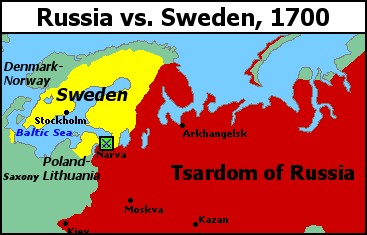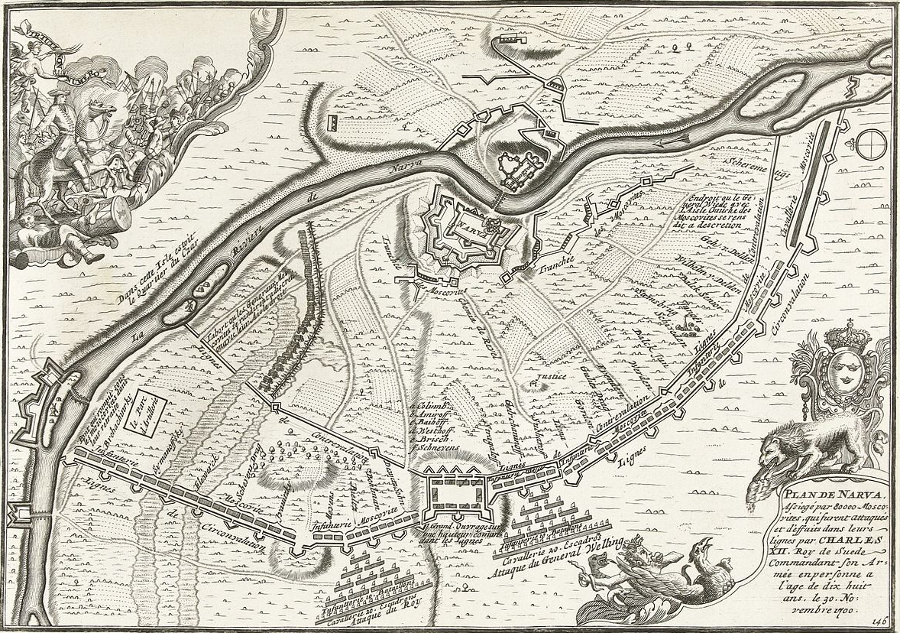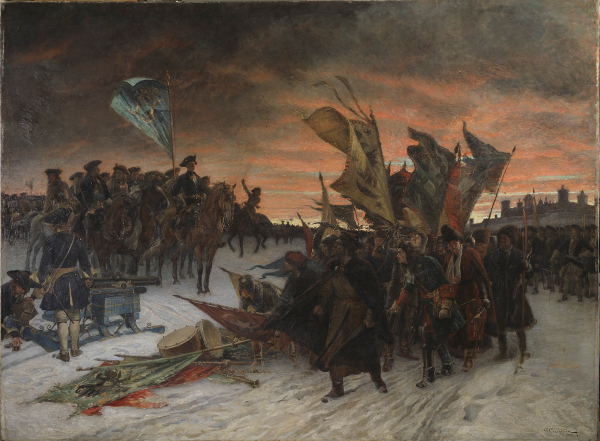

Pytor the Great: In War, in Peace, and in Cruelty
Pyotr fought numerous wars. While he did lose some battles and even wars, his victories made significant gains. Before Pyotr, Russia had limited access to the sea, which hindered its ability to trade with far-off lands. Arkhangelsk on the White Sea was frozen in for up to eight months each year, and the Pacific Ocean was too remote from Russia's cities. Pyotr's campaigns changed this.
In the south, Pyotr reached the Sea of Azov in 1696 and established Russia's first naval base there. However, Russian defeat by the Ottoman Empire in 1711 lost these gains.
In the west, Pyotr's decisive victory over Sweden gained lands along the eastern Baltic. This gave direct sea access to western Europe, and in 1703 Pyotr started construction of a new city, Sankt-Peterburg, on the Baltic. Sankt-Peterburg replaced Moskva as primary capital of Russia and became Pyotr's "Window on the West".
Comments

Map of Russia and Sweden, 1700
Russian Defeat at Narva, 1700
Many histories concentrate more on Pyotr I's victorious wars and battles, as Pyotr himself did when writing about his exploits in the Russian newspaper he founded. But, Pyotr also lost wars (such as the 1710-1711 war with the Ottoman Empire with Pyotr himself leading the Russian army) and major battles, such as the Battle of Narva in 1700. Pyotr himself was not at the battle, having left the day before, but his decisions had weakened the Russian army.
Pyotr wanted Russia to expand into the Baltic Sea region. One goal was to gain or build a port by the sea that would allow Russia to trade by sea with the countries in western Europe. Overland trade was slow and impractical. Significant sea trade via the Russian port of Arkhangelsk was also impractical. Not only was Arkhangelsk frozen in for about half of each year, but the city was also distant from Moskva and Russia's other major cities.
There was just one problem with Pyotr's wishes: Sweden. The Kingdom of Sweden was one of the most powerful countries in Europe at the time with an empire that dominated much of the Baltic Sea. The Swedish Army was modern and professional, unlike Pyotr's. However, Sweden had acquired numerous enemies, and Pyotr build a coalition that initially included Denmark-Norway and Saxony. Further, Sweden's monarch, Karl ("Charles") XII, had only become king in 1697 at the age of 15. Pyotr and his allies attacked Sweden from multiple directions in 1700, hoping for a quick victory over an overwhelmed and inexperienced Karl. Karl, instead, would prove to be a brilliant general, and Pyotr's war would drag on with many ups and downs and changes of alliances until 1721, when Russia finally won.
By November 1700, a 35,000-40,000-soldier Russian force under Pyotr was besieging about 2,000 Swedish soldiers and militiamen garrisoning the fortress of Narva. By this time, the Russians were the only forces still in the field against Sweden. Denmark-Norway had been forced to withdraw from the war entirely, and Pyotr's other ally had stopped campaigning and gone into winter quarters. Karl decided to attack the Russians. The Russians quickly heard of Karl's approach, but poor reconnaissance and Swedish misinformation led Pyotr to believe Karl had an army of 50,000. Pyotr left Narva, possibly to gather reinforcements, as 10,000 Russian soldiers and 11,000 Cossacks were present at other places in the region. The next day, Karl attacked with a force of 9,000-11,000 soldiers.

Map of the Battle of Narva, 1700 (engraving: "Plan de Narva" ["Map of Narva"]; unknown engraver; c. 1702. From Les Forces de l'Europe, Asie, Afrique et Amerique [The Forces of Europe, Asia, Africa and America]; Pieter Mortier; c. 1702)
With Pyotr gone, command of the Russian forces had been given to a visiting Saxon general, Charles Eugène de Croy. Earlier in 1700, Pyotr had begun a major reorganization of the Russian officer corps. Very many experienced officers had been retired or sent to command distant garrison posts, being replaced mostly by young Russian nobles who had little or no military experience. Fighting a major power with inexperienced, poorly-trained officers was a major mistake. Pyotr had even taken his Russian field marshal, Fyodor Golovin, with him, although Golovin was really an administrator rather than a field commander. Nonetheless, Pyotr's and Golovin's absence was another major mistake, as the Russian troops mistrusted foreign officers, de Croy included.
On the day of the battle, Karl's small force appeared before the Russians, and de Croy believed it was just the Swedish vanguard. Not so, and the Swedes attacked in the afternoon, in the midst of a snowstorm that greatly reduced visibility and supposedly blew snow into the Russian eyes. The Russians were outside the Narva fortifications but were hemmed in behind their own field fortifications, spread out to defend all four miles (6.5 km) of the line. Roughly in the center of the line was an all-around fort on a hill, a strong defensive position. Karl concentrated his forces into two assault groups, each attacking on one side of the hill to cut off the fort and then to roll up the Russian flanks on each side.
After a fierce but brief resistance by the Russians, the Swedes broke through. The spread-out Russian regiments took heavy casualties as they were attacked one after another, and parts of the Russian defense disintegrated. Russian soldiers began to attack foreign officers in their ranks, in the belief that the foreigners had betrayed them to the Swedes. This prompted de Croy to abandon the battle and surrender to the Swedes. Many Russians on the left flank tried to flee by crossing the Narva River on the only nearby bridge the Russians held, but the weight of their mass crossing collapsed it. However, the left flank did not completely collapse and even managed to counterattack at one point. The right flank was in serious trouble but two Russian Guards regiments formed a square that repulsed Swedish attacks and provided a haven for fleeing Russians. The battle wound down as night fell. The overall Russian force was leaderless and the surviving forces of the Russian flanks were out of contact with one other. During the next day, each flank separately surrendered to the Swedes.

The Russian surrender to Sweden at the Battle of Narva, 1700 (painting: Narva; Gustaf Cederström; 1905)
The Swedes had won a major victory with an outnumbered force, taking about 1,900 casualties. The Russians may have lost as many as 8,000 casualties and 10,000 prisoners. They also lost 173 out of the 195 cannon and siege guns that they had at Narva, a huge amount of Russia's artillery. Russia could not quickly replace these weapons, and in 1701 Russian units were short of artillery or lacking artillery altogether. However, Karl moved south to confront his other enemies (which would soon include Poland-Lithuania as well as Saxony) rather than pressing his advantage against the Russians. Although Pyotr had made mistakes, he did learn from them. He worked to reform and improve the Russian Army and to train his officers seriously. The next time an outnumbered Swedish Army attacked the Russian Army, at Poltava in 1709, the Russians would win a decisive victory. Nevertheless, the war with Sweden would continue until 1721, with Russia claiming all Swedish possessions on the south coast of the Baltic Sea.